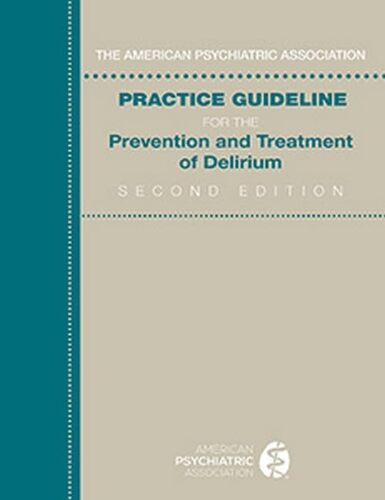American Psychiatric Association Practice Guideline For The Prevention & Treatment Of Delirium
| Item Information | |
|---|---|
| Item#: | 9780890428030 |
| Edition | 02 |
| Author | American Psychiatric Assoc. |
Prevalence rates of delirium range widely depending on patient population and treatment setting. Information on rates of delirium in community settings is limited, but in emergency and hospital settings, one-quarter or more of the patients will experience delirium. Rates can be even higher in older individuals, critical care patients, and patients who have had major orthopedic or cardiovascular surgeries.
Prevention, early detection, and optimal treatment are critical because delirium is often unrecognized and is associated with increased morbidity and mortality. For example, postsurgical delirium has been reported to have a 30-day mortality rate of up to 10%, versus 1% in postsurgical patients without delirium. Additionally, delirium exacts a significant economic toll on individuals, their families, and society because of longer hospital stays, ICU admissions, rehospitalizations, and lost wages. In the United States, direct health care costs of hospitalized older adults with delirium are significantly higher than hospitalized patients without delirium, even after adjusting for demographic and clinical factors.
The American Psychiatric Association Practice Guideline for the Prevention and Treatment of Delirium reviews current evidence-based nonpharmacological and pharmacological interventions to prevent or treat delirium in adults. In addition, it includes statements related to assessment and treatment planning, which are an integral part of patient-centered care. The guideline describes approaches to implementing recommendations and suggestions in clinical practice. By providing up-to-date knowledge, the guideline aims to help clinicians feel more confident in preventing, recognizing, and treating delirium, thereby improving the care and well-being of their patients.Evidence tables, literature search results, clinical questions, and more for this guideline can be found in the online appendixes.
Guideline Writing GroupSystematic Review GroupCommittee on Practice GuidelinesAPA Assembly LiaisonsTable of ContentsAcronyms/AbbreviationsIntroductionChapter 1. Guideline Statement SummaryChapter 2. Guideline Statements and ImplementationChapter 3. Nonpharmacological InterventionsChapter 4. Pharmacological InterventionsChapter 5. Transitions of CareChapter 6. Areas for Further ResearchChapter 7. Guideline Development ProcessAppendicesAppendix A. Clinical QuestionsAppendix B. Search Strategies, Study Selection, and Search ResultsAppendix C. Review of Research Evidence Supporting Guideline StatementsAppendix D. Evidence Tables for Individual Studies Supporting Guideline StatementsAppendix E. Risk of Bias Ratings for Individual Studies Supporting Guideline StatementsAppendix F. Review of Benefits and Harms, Patient Preferences, and Other Practice GuidelinesAppendix G. Description of Additional Studies ReviewedAppendix H. Evidence Tables for Additional Studies ReviewedAppendix I. Considerations in the Use of Guidelines to Enhance the Quality of CareReferences

